The city of Richmond’s loss could turn out to be Henrico County’s gain as the development team behind the failed Navy Hill proposal is now planning a comparable arena-anchored development at the site of the former Best Products headquarters in the county.
Henrico officials on Tuesday announced plans for GreenCity, a $2.3 billion development that would span 200 acres northeast of the Interstate 95-Parham Road interchange. The land consists of the county-owned Best site and more than 100 acres to the north owned by Bill Goodwin’s Riverstone Properties.
Envisioned as a so-called “ecodistrict” village, the development would be anchored by a $250 million, 17,000-seat arena, and include 2.2 million square feet of office space, 280,000 square feet of retail, two hotels, up to 2,400 residential units, and green space.
Behind the development are Michael Hallmark and Susan Eastridge, the team that a group of Richmond business heavyweights, including Goodwin, enlisted to design the former Navy Hill plan that a majority of Richmond City Council rejected in February. Navy Hill was likewise based around a similar-sized arena that was proposed to replace the shuttered Richmond Coliseum.
Where that $1.5 billion plan hinged on taxpayer support through a proposed tax-increment financing (TIF) district, officials said GreenCity would be different in that it would utilize another funding mechanism called a community development authority (CDA), which Henrico has used with such developments as Short Pump Town Center, White Oak Village and Reynolds Crossing.
In GreenCity’s case, Henrico would establish a CDA for the project site that would generate tax revenue to support the development as it progresses, expected over a period of 10 to 12 years. Thirty-year bonds used to finance the project would be paid off with tax revenue from the development’s initial phases, as well as from revenues generated from the arena.
“This is a private development that calls for no use of existing county funds and no upfront investment by the county,” said Dan Schmitt, vice chairman of the Henrico County Board of Supervisors. He said GreenCity is projected to generate $20 million a year for the county once the bond debt is retired in 30 years, if not sooner.
“This carries no financial risk to our taxpayers. This will not add to the county’s debt. However, it will provide us with jobs, investment and countless other benefits,” Schmitt said, noting that those benefits would be realized during the development.
He added, “I congratulate the developers for their vision. I look forward to reviewing this project and its finances in greater detail as we continue to move forward. It’s a great day in Henrico.”
Tuesday’s announcement represented Henrico’s endorsement of the project. While a private development, Henrico would support it through rezoning approvals, creation of the CDA, and transferring the county-owned Best site’s 92 acres to the Henrico Economic Development Authority, County Manager John Vithoulkas said.
The EDA would then sell its site for $6.2 million, the amount it paid for the property in 2011, when it planned to convert the headquarters building into a government center. Those plans didn’t go forward, and the county has spent $350,000 annually to maintain the 286,000-square-foot building, which would be incorporated into the GreenCity development.
“This is what we do in Henrico: smart economic partnerships with no risk and significant benefit to the taxpayer,” Vithoulkas said.

Henrico County Manager John Vithoulkas speaking Tuesday in front of the Best Products building. (Jonathan Spiers photo)
“We’re talking about a new kind of community that is intricately planned, that is inclusive for all and thoughtfully designed to not only be livable but also environmentally sustainable,” he said. “A community that preserves, embraces and showcases open space, that drives economic development and tourism in new and exciting ways, while also remaining respectful to county taxpayers.”
Land sales pending
Next steps include the purchase of the Goodwin-owned land, a 110-acre assemblage known as Scott Farm. Jeff Galanti, a principal with Goodwin’s Riverstone Properties, said discussions are ongoing with Hallmark and Eastridge, whose GreenCity LLC would purchase the land. Galanti said the purchase is contingent on rezoning and could involve all or some portion of the land.
Riverstone purchased Scott Farm in early 2015, paying more than $6.41 million combined for four parcels that make up the land. Those parcels were most recently assessed by the county in excess of $1.64 million collectively. With the Best property assessed at $8.54 million, the overall assessed value of the combined 205-acre site is about $10.19 million.
Galanti said he was approached about the project soon after Hallmark and Eastridge reached out to Vithoulkas, apparently in the wake of the Navy Hill vote in February. In his remarks Tuesday, Vithoulkas said Hallmark and Eastridge have been working on GreenCity for nine months, putting the start of the project’s design timeline at about March.
In January, just weeks before the Navy Hill vote, Henrico supervisors directed Vithoulkas to market the Best site for economic development along with the Goodwin land through a potential joint request for proposals. A formal RFP never went out, as the county put the proposal on hold due to the pandemic, EDA Director Anthony Romanello said.
Galanti said the timing of the RFP proposal and the Navy Hill vote was a coincidence.
“It’s pure coincidence on the timing. I’d say it’s a very fortunate coincidence for us,” Galanti said after the announcement.
“We were looking at what needed to be developed on the parcel as a whole to unlock it. We were really thinking commercial, something to get the front door established,” he said. “Obviously, this is commercial on steroids.”
Galanti said Goodwin is not a cash investor in GreenCity. Neither are the other business heavyweights, such as Dominion Energy CEO Tom Farrell, who were involved in Navy Hill, according to materials distributed at the event.
A list of frequently asked questions distributed Tuesday said Navy Hill’s corporate backers are not involved in GreenCity “at this point,” adding that the developers “hope there will be involvement by the business community in the future.”
‘Ecodistrict’ development
Hallmark said GreenCity would incorporate sustainable development practices, such as net-zero energy and water usage, and involve mixed-income housing and promote small- and minority-owned businesses. The residential units would include a mix of rental and for-sale housing types, with an unspecified number designated as “affordable” units.
Hallmark, a principal with Richmond-based Future Cities, described the project’s “ecodistrict” concept as incorporating existing forests and wetlands into the community, with a park system that would include a 1.5-mile trail, restored streams and other amenities.
“The vision for GreenCity brings together existing best practices in sustainability science with climate commitments,” Hallmark said. “These are commitments already embraced by individuals and businesses all around the world, but not always supported by the cities that we are building today.”
Added Eastridge, who is president of Northern Virginia-based development firm Concord Eastridge: “In a post-COVID world, people eventually will come back together. But they will come back to a new normal, which must include better building design, smarter heating-ventilation-air-conditioning systems, more indoor-outdoor design, and more direct connections to nature.”
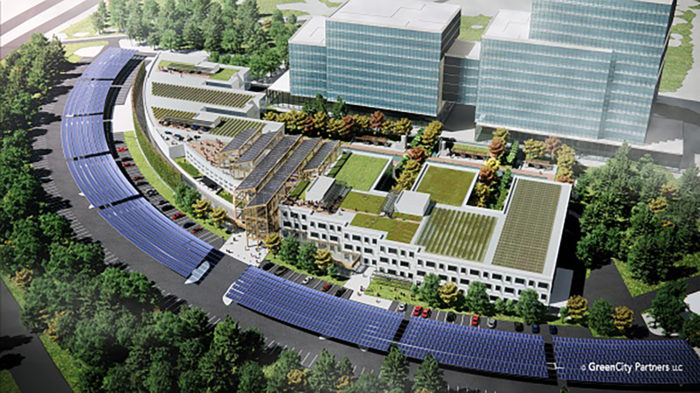
The development would incorporate sustainable development practices such as solar energy panels. (Courtesy of GreenCity LLC)
Vithoulkas said the board would propose transferring the Best site to the EDA at its Jan. 26 meeting. Rezoning applications would be filed around that time, with the project using the county’s urban mixed-use zoning district.
That would kick off a three-year process to assemble and prep the land. A project timeline distributed Tuesday calls for the arena bonds to close in 2023, the arena opening in 2025, and GreenCity completing buildout in 2033.
Other projects underway
Tuesday’s announcement comes as Henrico is also working with developers to redevelop the nearby Virginia Center Commons mall, which is planned to house a smaller, county-owned arena that would be used for indoor sports and high school graduations.
It also comes as Hallmark and Eastridge are pursuing a separate development in the city: a $350 million, 20-story tower and mixed-use office complex that would replace Richmond’s Public Safety Building. That proposal appears to still be in play as the city wraps up related planning efforts, such as small area plans tied to the Richmond 300 master plan update.
That project would salvage some portions of Navy Hill, which had the support of Richmond Mayor Levar Stoney’s administration. On Tuesday, Lincoln Saunders, Stoney’s chief of staff, provided a statement in reaction to the GreenCity announcement.
“Obviously, Mayor Stoney believed an arena-anchored mixed-use redevelopment was a great opportunity to redevelop downtown and generate revenues and benefits for the city. Henrico’s announcement today shows that this vision had merit, and the mayor wishes them well and he’s glad that the region will benefit,” Saunders’ statement said.
Saunders added that the city has other economic development opportunities it would pursue in coming years. In addition to the Public Safety Building redevelopment, those opportunities include a proposed casino near Manchester and an anticipated RFP for development of city-owned land along Arthur Ashe Boulevard that would replace The Diamond and make way for a new baseball stadium.
City Councilmember Stephanie Lynch, who was among the council majority who voted down Navy Hill, said Tuesday that the city would focus on those projects, describing the GreenCity proposal as a win for the region.
“I think it’s an exciting opportunity for us to put some energy and motivation behind some of the projects that we have already underway,” Lynch said. “I don’t pit us in direct competition with Henrico. I think that this is going to help strengthen us as a region.”
The city of Richmond’s loss could turn out to be Henrico County’s gain as the development team behind the failed Navy Hill proposal is now planning a comparable arena-anchored development at the site of the former Best Products headquarters in the county.
Henrico officials on Tuesday announced plans for GreenCity, a $2.3 billion development that would span 200 acres northeast of the Interstate 95-Parham Road interchange. The land consists of the county-owned Best site and more than 100 acres to the north owned by Bill Goodwin’s Riverstone Properties.
Envisioned as a so-called “ecodistrict” village, the development would be anchored by a $250 million, 17,000-seat arena, and include 2.2 million square feet of office space, 280,000 square feet of retail, two hotels, up to 2,400 residential units, and green space.
Behind the development are Michael Hallmark and Susan Eastridge, the team that a group of Richmond business heavyweights, including Goodwin, enlisted to design the former Navy Hill plan that a majority of Richmond City Council rejected in February. Navy Hill was likewise based around a similar-sized arena that was proposed to replace the shuttered Richmond Coliseum.
Where that $1.5 billion plan hinged on taxpayer support through a proposed tax-increment financing (TIF) district, officials said GreenCity would be different in that it would utilize another funding mechanism called a community development authority (CDA), which Henrico has used with such developments as Short Pump Town Center, White Oak Village and Reynolds Crossing.
In GreenCity’s case, Henrico would establish a CDA for the project site that would generate tax revenue to support the development as it progresses, expected over a period of 10 to 12 years. Thirty-year bonds used to finance the project would be paid off with tax revenue from the development’s initial phases, as well as from revenues generated from the arena.
“This is a private development that calls for no use of existing county funds and no upfront investment by the county,” said Dan Schmitt, vice chairman of the Henrico County Board of Supervisors. He said GreenCity is projected to generate $20 million a year for the county once the bond debt is retired in 30 years, if not sooner.
“This carries no financial risk to our taxpayers. This will not add to the county’s debt. However, it will provide us with jobs, investment and countless other benefits,” Schmitt said, noting that those benefits would be realized during the development.
He added, “I congratulate the developers for their vision. I look forward to reviewing this project and its finances in greater detail as we continue to move forward. It’s a great day in Henrico.”
Tuesday’s announcement represented Henrico’s endorsement of the project. While a private development, Henrico would support it through rezoning approvals, creation of the CDA, and transferring the county-owned Best site’s 92 acres to the Henrico Economic Development Authority, County Manager John Vithoulkas said.
The EDA would then sell its site for $6.2 million, the amount it paid for the property in 2011, when it planned to convert the headquarters building into a government center. Those plans didn’t go forward, and the county has spent $350,000 annually to maintain the 286,000-square-foot building, which would be incorporated into the GreenCity development.
“This is what we do in Henrico: smart economic partnerships with no risk and significant benefit to the taxpayer,” Vithoulkas said.

Henrico County Manager John Vithoulkas speaking Tuesday in front of the Best Products building. (Jonathan Spiers photo)
“We’re talking about a new kind of community that is intricately planned, that is inclusive for all and thoughtfully designed to not only be livable but also environmentally sustainable,” he said. “A community that preserves, embraces and showcases open space, that drives economic development and tourism in new and exciting ways, while also remaining respectful to county taxpayers.”
Land sales pending
Next steps include the purchase of the Goodwin-owned land, a 110-acre assemblage known as Scott Farm. Jeff Galanti, a principal with Goodwin’s Riverstone Properties, said discussions are ongoing with Hallmark and Eastridge, whose GreenCity LLC would purchase the land. Galanti said the purchase is contingent on rezoning and could involve all or some portion of the land.
Riverstone purchased Scott Farm in early 2015, paying more than $6.41 million combined for four parcels that make up the land. Those parcels were most recently assessed by the county in excess of $1.64 million collectively. With the Best property assessed at $8.54 million, the overall assessed value of the combined 205-acre site is about $10.19 million.
Galanti said he was approached about the project soon after Hallmark and Eastridge reached out to Vithoulkas, apparently in the wake of the Navy Hill vote in February. In his remarks Tuesday, Vithoulkas said Hallmark and Eastridge have been working on GreenCity for nine months, putting the start of the project’s design timeline at about March.
In January, just weeks before the Navy Hill vote, Henrico supervisors directed Vithoulkas to market the Best site for economic development along with the Goodwin land through a potential joint request for proposals. A formal RFP never went out, as the county put the proposal on hold due to the pandemic, EDA Director Anthony Romanello said.
Galanti said the timing of the RFP proposal and the Navy Hill vote was a coincidence.
“It’s pure coincidence on the timing. I’d say it’s a very fortunate coincidence for us,” Galanti said after the announcement.
“We were looking at what needed to be developed on the parcel as a whole to unlock it. We were really thinking commercial, something to get the front door established,” he said. “Obviously, this is commercial on steroids.”
Galanti said Goodwin is not a cash investor in GreenCity. Neither are the other business heavyweights, such as Dominion Energy CEO Tom Farrell, who were involved in Navy Hill, according to materials distributed at the event.
A list of frequently asked questions distributed Tuesday said Navy Hill’s corporate backers are not involved in GreenCity “at this point,” adding that the developers “hope there will be involvement by the business community in the future.”
‘Ecodistrict’ development
Hallmark said GreenCity would incorporate sustainable development practices, such as net-zero energy and water usage, and involve mixed-income housing and promote small- and minority-owned businesses. The residential units would include a mix of rental and for-sale housing types, with an unspecified number designated as “affordable” units.
Hallmark, a principal with Richmond-based Future Cities, described the project’s “ecodistrict” concept as incorporating existing forests and wetlands into the community, with a park system that would include a 1.5-mile trail, restored streams and other amenities.
“The vision for GreenCity brings together existing best practices in sustainability science with climate commitments,” Hallmark said. “These are commitments already embraced by individuals and businesses all around the world, but not always supported by the cities that we are building today.”
Added Eastridge, who is president of Northern Virginia-based development firm Concord Eastridge: “In a post-COVID world, people eventually will come back together. But they will come back to a new normal, which must include better building design, smarter heating-ventilation-air-conditioning systems, more indoor-outdoor design, and more direct connections to nature.”

The development would incorporate sustainable development practices such as solar energy panels. (Courtesy of GreenCity LLC)
Vithoulkas said the board would propose transferring the Best site to the EDA at its Jan. 26 meeting. Rezoning applications would be filed around that time, with the project using the county’s urban mixed-use zoning district.
That would kick off a three-year process to assemble and prep the land. A project timeline distributed Tuesday calls for the arena bonds to close in 2023, the arena opening in 2025, and GreenCity completing buildout in 2033.
Other projects underway
Tuesday’s announcement comes as Henrico is also working with developers to redevelop the nearby Virginia Center Commons mall, which is planned to house a smaller, county-owned arena that would be used for indoor sports and high school graduations.
It also comes as Hallmark and Eastridge are pursuing a separate development in the city: a $350 million, 20-story tower and mixed-use office complex that would replace Richmond’s Public Safety Building. That proposal appears to still be in play as the city wraps up related planning efforts, such as small area plans tied to the Richmond 300 master plan update.
That project would salvage some portions of Navy Hill, which had the support of Richmond Mayor Levar Stoney’s administration. On Tuesday, Lincoln Saunders, Stoney’s chief of staff, provided a statement in reaction to the GreenCity announcement.
“Obviously, Mayor Stoney believed an arena-anchored mixed-use redevelopment was a great opportunity to redevelop downtown and generate revenues and benefits for the city. Henrico’s announcement today shows that this vision had merit, and the mayor wishes them well and he’s glad that the region will benefit,” Saunders’ statement said.
Saunders added that the city has other economic development opportunities it would pursue in coming years. In addition to the Public Safety Building redevelopment, those opportunities include a proposed casino near Manchester and an anticipated RFP for development of city-owned land along Arthur Ashe Boulevard that would replace The Diamond and make way for a new baseball stadium.
City Councilmember Stephanie Lynch, who was among the council majority who voted down Navy Hill, said Tuesday that the city would focus on those projects, describing the GreenCity proposal as a win for the region.
“I think it’s an exciting opportunity for us to put some energy and motivation behind some of the projects that we have already underway,” Lynch said. “I don’t pit us in direct competition with Henrico. I think that this is going to help strengthen us as a region.”

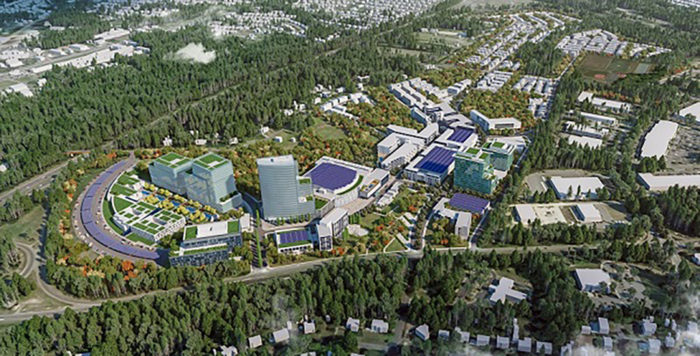
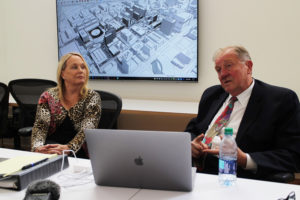

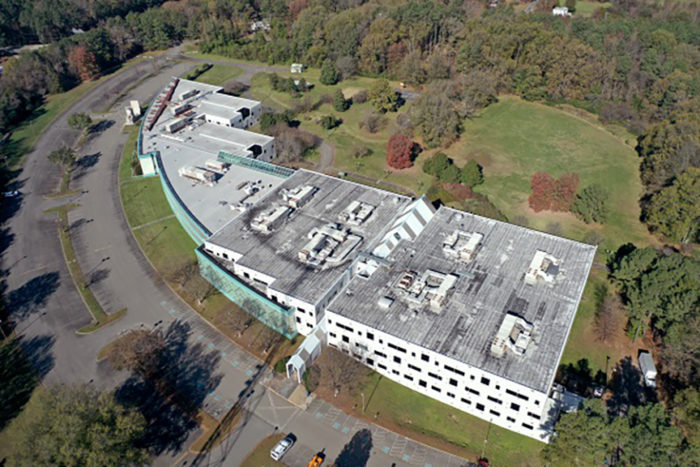
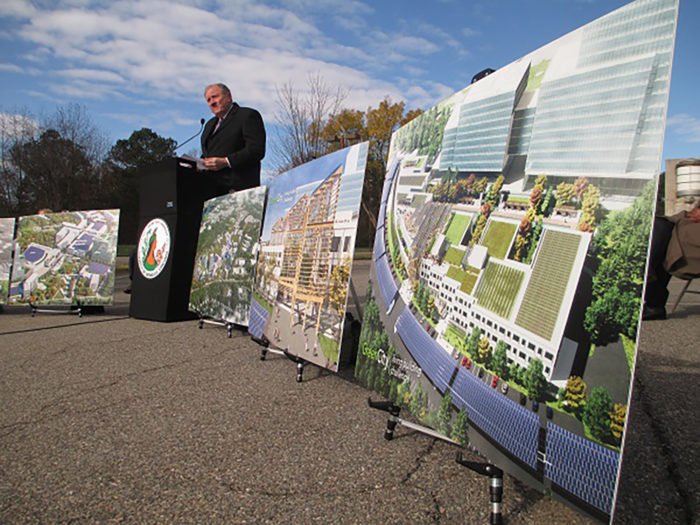


If this project breaks ground, it will be the last nail in the coffin for establishing that the City can no longer find its way out of a paper bag, with a map and a flashlight.
And the residents are ok with this, which is baffling. Stoney re-elected and a schools super who doesn’t seem to want to have kids in school. I truly wonder what are the priorities of City residents these days, self destruction seems to be one of them.
The city is on its firmest revenue base in its history with its population expected to balloon 35% or more in the next two decades. As a 25 year resident, I’m glad the city will not be saddled with the expense of an arena that is better located elsewhere and only pays for itself once its already out of date. As for the schools being closed temporarily, it’s not alone, as all the public schools locally are closed until lives are no longer in danger from this virus. Your remarks are remarkable only in ignorance.
Your numbers do not take into account the most recent displays of incompetence by city officials in letting rioters destroy public and private property alike for months by once again showing no leadership at all.There are a large number of folks that have not, and will not spend another dime in the city limits. But yet the residents of the city blindly elect the same garbage back into office. RVA city council has been a joke for 40 plus years. The counties have propped up the city for that same time period and I applaud them for taking the bull… Read more »
Come on Fred. Arenas in small non-big 5 sports markets are money losers for their jurisdictions more often than not. We can all point to a few exceptions like Greensboro which has the largest arena in ACC country and was built before construction costs have snowballed. But as much as I love Richmond who honestly thinks were going to have success that is the exception rather than typical for a market our size? I certainly didn’t want to have to pay back 600 million on 300 million bonds over 30 years for a entertainment toy that loses money and maybe… Read more »
Sorry, I should have provided clarity in that I was not referring to a sports arena which I will agree is a total money loss for whatever region it lands in. I was simply referring to the lack of any action by the City to do anything. They could still have encouraged development on a private level without an arena. But Instead they shut any idea down that area will sit barren. I stand by my comments that schools should have opened when the counties did, no real data is showing young kids in schools being the biggest spread of… Read more »
This points to the failure of Richmond as a region. It is held hostage to the independent city/suburban counties governmental structure that we have in Virginia. Our competitors (Raleigh, Charlotte, etc) don’t have to deal with this and have grown and prospered to a far greater degree than the Richmond region in the last 40 years. This arena should have been built downtown or near the Diamond. That being said, the city will still benefit. The Henrico location is close to the city, with good access to downtown and Carytown. People visiting the region who are coming to arena events… Read more »
If this is such a great idea, why do private-sector investors need public-sector money to make money? I am a Henrico County taxpayer. What is my above market interest rate for lending to this speculative real estate venture? What is my equity cut? When do my checks start coming?
Here is a question I would like to see answered. Please reply to this comment and send links showing the profitability of similar developments in similar communities. I am open to persuasion.
C. Jay – Would you have said the same thing 30 years ago when they approved Innsbrook if the same type of bonds were used? Projects that lead to many good jobs, higher salaries, more tourism, etc. etc. etc. benefit the entire community both directly and indirectly. If this is successful just the property tax base alone would be $22 million additional county dollars annually and that does not include additional sales tax, business personal property tax, hotel taxes and the increase in surrounding development that will surely follow. All in all it could easily lead to 40-50 million per… Read more »
This looks like a neat project but I hope Henrico County is ready to feed the road funding monster which looks like it’s going to be pretty hungry with this project. At the least they should add sidewalks to all streets and improve all intersections with in a mile or two of this project. They are also going to need to widen a 5 mile section of Interstate 95 to 8 lanes by adding a lane or two of pavement to avoid the Intersection of 95 and 295 getting blocked up. They also should add a lane of pavement to… Read more »
My question to the City of Richmond is what happens to the Coliseum now? How long will this eyesore remain ? My suggestion to the city is to bite the bullet and demolish the Coliseum sooner rather than later and position all of the land surrounding it for alternative uses including affordable housing, which the City desperately needs. The city can recover the cost of demolition by selling the property to developers.
Oh the joy in watching Richmond sit stagnant as opportunities arise… and pass. New schools, higher teacher salaries and infrastructure improvements don’t just “happen” as so many would like to believe. You have to take calculated risks which has proven to be something the City has never been good with. Good on you, Henrico! Sucks to be you, Richmond.
And yet the sky downtown is full of cranes and new buildings. Just because one project was a lame duck doesn’t mean all opportunities are lost. The city is growing at an exponential rate.
How many of those cranes downtown are government or VCU related tax spending vs. tax paying private development that made a calculated risk to invest? Can anyone answer this?
I believe 100% of them are VCU and/or government projects.
Ding ding ding. I’d love to see a comparison of these “exponential growth” numbers for RVA against VCU’s growth… VCU will only carry Richmond on their coattails for so long.
The current four large hammerhead style tower cranes are VCU/State but we did have as many as five up within the past year for private construction as well. Currently we also have a good half dozen smaller tower cranes operating on private developments with many more expected to begin soon (including several projects warranting larger tower cranes).
And how many of those were for residential/office? The more residents you have, the more amenities are needed to keep them here/happy.
2 for office, 3 for residential. Most future will be residential and the vast majority is aimed at wealthier, childless tenants, therefore, a net gain for the school system budget without higher demand. While the arena is certainly a loss for visitor draw, which hurts, residents are moving to cities for walkability and proximately to amenities like restaurants, which unlike offices, will certainly prosper again.
I’m no real estate expert, but I would have to think that the Henrico plan will be revised. Does any city/county need more office & retail space? Sure, it will take years to build but I anticipate demand for both will get worse before it gets better.